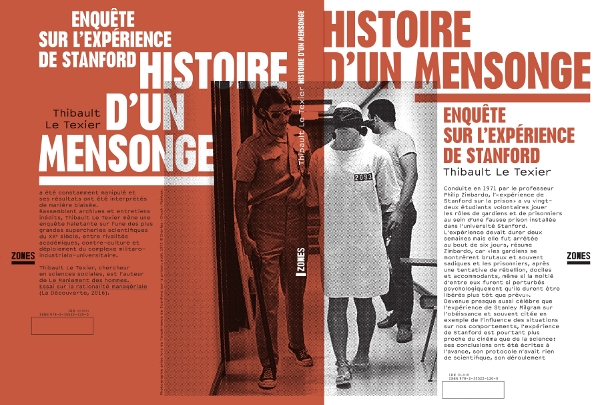
Histoire d’un mensonge : enquête sur l’expérience de Stanford
La Découverte, « Zones », avril 2018
Conduite en 1971 par le professeur Philip Zimbardo, l’« expérience de Stanford sur la prison » a vu vingt-deux étudiants volontaires jouer les rôles de gardiens et de prisonniers au sein d’une fausse prison installée dans l’université Stanford.
L’expérience devait durer deux semaines mais elle fut arrêtée au bout de six jours, résume Zimbardo, car « les gardiens se montrèrent brutaux et souvent sadiques et les prisonniers, après une tentative de rébellion, dociles et accommodants, même si la moitié d’entre eux furent si perturbés psychologiquement qu’ils durent être libérés plus tôt que prévu ».
Devenue presque aussi célèbre que l’expérience de Stanley Milgram sur l’obéissance et souvent citée en exemple de l’influence des situations sur nos comportements, l’expérience de Stanford est pourtant plus proche du cinéma que de la science : ses conclusions ont été écrites à l’avance, son protocole n’avait rien de scientifique, son déroulement a été constamment manipulé et ses résultats ont été interprétés de manière biaisée.
- Plus de détails sur le site de Zones.
- Entretien avec Grégory Salle sur le site de Contretemps.
- Entretien avec Sonya Faure dans Libération.
History of a Lie : Debunking the Stanford Prison Experiment
In 1971, the famous Stanford Prison Experiment aimed to show that normal people could behave in pathological ways, becoming hostile and sadistic, under the influence of their environment.
Based on a thorough investigation in the archives of the experiment and on interviews with about half the people who participated in it, this book shows that the Stanford experiment is closer to cinema than science. In particular, it provides strong and numerous evidences that :
- The SPE was modeled after a student experiment : The Toyon Hall experiment.
- The guards knew what results were expected from them.
- The guards were trained and supervised by the experimenters.
- The guards were following a schedule and a set of rules written by the experimenters.
- The experimenters deceived the guards and made them believe they were not subjects.
- The participants responded to demand characteristics.
- The prisoners were conditioned by the experimenters.
- The prisoners were not allowed to leave the experiment at will.
- The mock prison situation was unrealistic and most participants did not forget they were participating in an experiment.
- The data was not collected properly.
- The experiment was inaccurately reported.
- The conclusions were pre-written according to non-academic aims.
- Rationally Speaking podcast, hosted by Julia Galef (podcast & full transcript here).
- You’re Wrong About podcast, hosted by Michael Hobbes and Sarah Marshall (here).

.